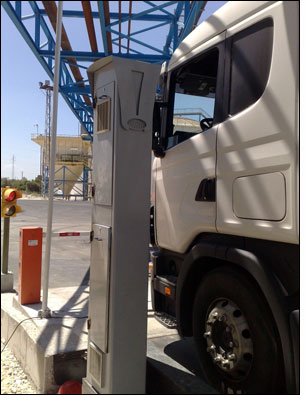Azucarera Ebro, a leading sugar manufacturer in Spain and part of the British Sugar Group—the second largest sugar producer in the world—is employing radio frequency identification to gain better visibility into, and control over, its operations at a refinery in the Guadalete region of southern Spain. The new system has reduced the amount of paperwork that truck drivers coming into and out of the refinery must manage, and also makes their movements more efficient, according to Zetes, a European auto-ID technology systems integrator that helped Azucarera design and implement system.
Previously, a truck driver went through manual steps that would serve to identify that individual and his vehicle, as well as track the loads the truck carried into and out of the refinery. But by using RFID, these steps have been automated and streamlined.
Azucarera first tested the system in summer 2009, before permanently installing the RFID hardware this winter. Prior to that, drivers needed to present paperwork with a printed bar code every time they came to the gates, and as they visited stations within the facility, such as scales used to weigh the trucks.
Azucarera Ebro is using Identec Solutions i-Q 868 MHz active RFID tags. Identec Solutions’ i-Port readers are mounted at the entrance and exit gates, as well as at scales. Zetes middleware links the RFID hardware with a number of devices at the refinery, including gate controllers and scales, so that business processes can be automated.
Jordi Soler, the professional services manager for Zetes’ Spanish branch, explains that the tags are used to uniquely identify each truck and the reason for its visit (either dropping off raw materials, or picking up processed goods). Upon arriving at the facility, a truck driver identifies himself and provides documentation to an Azucarera employee at the front gate, who uses this information to call up the appropriate order data in the company’s warehouse-management system. The employee then selects a battery-powered 868 MHz RFID tag, reads it to collect its unique ID number, and associates this ID with the order information in Azucarera’s warehouse-management software—part of its SAP enterprise software platform. The driver then places this tag on the dashboard of his truck.
If the truck is bringing raw materials (generally, sugar beets) into the facility, it proceeds to a scale where its gross weight is recorded, both in the SAP software and on the tag itself, along with a timestamp. After the vehicle is unloaded, it is weighed once more in order to determine the load’s weight. Again, this information and a timestamp are recorded in the SAP platform, as well as on the tag’s memory.
A truck entering the facility in order to pick up a load of finished product and bring it to the harbor is also issued an RFID tag, after the driver presents his order information to the front-gate personnel.
If the truck makes multiple trips between the refinery and the harbor on a single day, the driver keeps the tag in the truck so that the interrogator will read that tag and automatically trigger the gates to open as the vehicle re-enters and re-exits the factory. This is important, because it gives Azucarera a means of tracking the amount of raw materials brought into the facility, and also lets it know which supplier shipped those goods. This automates the billing process.
Trucks carrying multiple loads of finished material out of the refinery, and to the harbor, are tracked similarly. Before leaving the facility for the last time on a given day, the driver returns the tag to a gate employee, so that the pool of tags is reused continuously.


